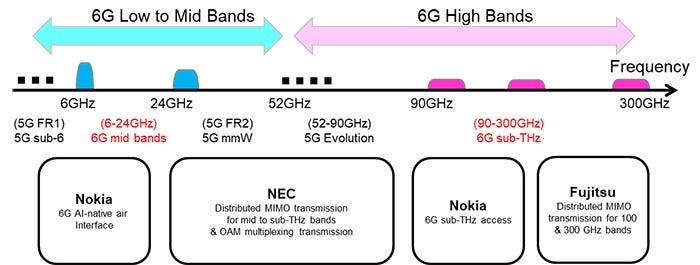NTT, Fujitsu, NEC and Nokia put their heads together for 6G trialsNTT, Fujitsu, NEC and Nokia put their heads together for 6G trials
An Avengers-style mash up of telecoms firms are collaborating on experimental trials of new communications technologies expected to be underpinned by 6G.
June 6, 2022

An Avengers-style mash up of telecoms firms are collaborating on experimental trials of new communications technologies expected to be underpinned by 6G.
NTT and NTT DoCoMo appear to be leading the trials, which are apparently designed to verify new mobile technologies, including those using frequencies in the millimetre and sub-terahertz (above 6 GHz) bands, and AI-based wireless transmission methods. The general idea is to accelerate the global standardization and commercialization of 6G before it is launched, which they expect will be around 2030.
Setting out some ground rules, NTT says that 6G will exceed the performance of 5G (as you’d hope) use new high-frequency bands such as sub-terahertz bands above 100 GHz, and enable both ultra-low-power consumption and low-cost communications. Indoor Trials will begin in begin in the fiscal year ending March 2023, with outdoor trials expected the following year.
“6G studies are progressing two or three years ahead of that of 5G,” said Naoki Tani, CTO at DoCoMo. “From this early stage, we would like to collaborate with world-leading global vendors to proactively demonstrate breakthrough concepts and technologies and promote them to the world.”
NTT doesn’t go into much more detail than that with regards to the details of the trials, however its tech partners have also put out some info on what it is they are working on. Nokia says the initial focus of the partnership is to demonstrate the benefits of AI-based learned waveform in the transmitter with a deep learning receiver in the mid-band, and that they also want to test high data rate indoor communications in the sub-THz band. Nokia reckons providing high-rate access will underpin 6G use cases, such as ‘multi-modal mixed-reality telepresence and remote collaboration, massive twinning and collaborating robots.’
“We envision that 6G will unify the human experience across the digital, physical and human worlds,” said Peter Vetter, President Bell Labs Core Research, Nokia. “We build on a long tradition of collaborations between the world-leading labs at DoCoMo and Nokia Bell Labs. Nokia is very honored to engage in this collaboration with DoCoMo and NTT, as global leading operators that are always among the first to bring new generations to the market. We look forward to working together and validating key concepts and key technologies to realize the 6G vision.”
Fujitsu said in its release that it is aiming to develop high-frequency wireless devices utilizing compound semiconductors such as gallium nitride (GaN) and indium phosphorus (InP). It also said it will “will promote the development of technologies for the realization of practical applications for 6G and actively engage in global 6G standardization activities to contribute to solving societal issues through R&D.”
Since it has yet to be firmly understood exactly what role 5G will end up playing in technology and wider society, it could be argued that defining what 6G will be is a little premature. There is nothing wrong with getting ahead of the curve of course, but part of the problem with 5G is that the use cases especially on the consumer side sometimes still feel a bit woolly, and we’re now well into the rollout of that.
The tech bods at these firms know what they are doing we are sure, however one lesson we’d argue that could be taken from 5G marketing as the gears start spinning for 6G is to be more specific with what it is the tech can do for people in the real world, and not relay on gimmicky use cases. The use cases held up by Nokia include ‘multi-modal mixed-reality telepresence and remote collaboration, massive twinning and collaborating robots’ feel like more of the same, but it will certainly be interesting so see how the firms behind the latest mobile comms standard position it as it develops.

Get the latest news straight to your inbox. Register for the Telecoms.com newsletter here.
About the Author
You May Also Like










.png?width=300&auto=webp&quality=80&disable=upscale)


_1.jpg?width=300&auto=webp&quality=80&disable=upscale)